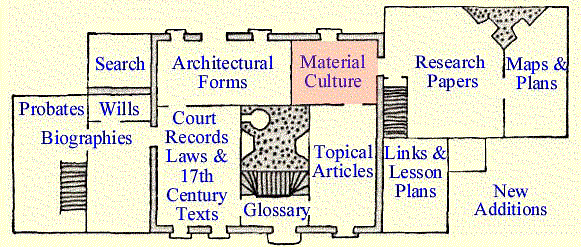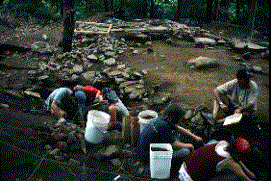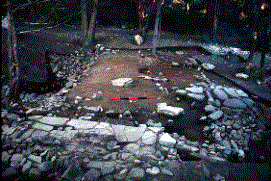Archaeological Field School and Excavations, 1998-2003 |
| The Department of Anthropology of the University of Virginia was pleased to conduct field school excavations at the Howland Site in Kingston, Massachusetts in 1998 and 1999. These intensive five-week courses in historical archaeology provided participants with a working knowledge of standard archaeological methods and laboratory procedures through the continued excavation of a site occupied by three generations of Howlands starting in 1638. Derek Wheeler was the field director, working under the supervision of James Deetz, and Derek has continued this excavation project over the past few years. Here he provides reports of his findings thus far.
Excavations at the Howland Site, 1998-1999The 1999 excavations centered on a 17 x 33 foot stone foundation partially excavated in 1937-38 and re-exposed during the 1998 field season. The field school in 1998 focused on mapping the structure and identifying unexcavated strata. In 1999, Mr. Wheeler and his students fully excavated a large, seven by twenty foot cellar located to the north of this dwelling. They also continued excavations around the foundation's walls to accurately map and date this late seventeenth to early eighteenth century building (see Figure 4, below). In addition, they worked to survey the twenty-acre property to locate the dwelling house, barn and outbuildings that were sold to John Howland in 1638. Our goals were to examine how the earliest colonial structures were built, to understand the spatial layout of this early farmstead and to examine how its organization evolved during the Plymouth Colony period (1620-1691). The John Howland Site is located at Rocky Nook in Kingston which is four miles north of Plymouth and forty miles south of Boston, Massachusetts. The excavation team camped on the property owned and operated by Plimoth Plantation, a re-created village of the fortified town of Plymouth as it looked in 1627. This provided the students with a unique opportunity to observe and interact with the Plantation's artisans and interpreters. Coupled with their extensive library and documentary resources, the students were able to obtain an excellent understanding of early seventeenth century material culture and lifeways. Excavations at the Howland Site, 2003 UpdatesThe week preceding the August, 2003, Pilgrim John Howland Society ("PJHS") annual meeting was a busy one at the original Howland homesite in Kingston, Massachusetts. The week of August 18 through August 23 was the fourth summer of archaeological excavations on the property involving Howland descendants. The property owned by the PJHS is located on a small peninsula of land called Rocky Nook and represents the core of the farmstead purchased by John from John Jenny in 1638 and held by three generations of Howlands. Upon John's passing, the property went to his second eldest son, Joseph, who in turn gave it to his son James. James sold the property off in pieces, with the last being sold out of the Howland hands in 1725 (until the PJHS reacquired the land in 1920). In 1937, Sydney Strickland, an architect from Boston, was hired to locate the original Howland dwelling purchased by John and listed in the 1638 deed. Strickland and his team quickly found the remains of a large dwelling measuring 34 by 17 feet with a large, nine-foot wide chimney on the west end and a 8 by 22 addition to the north with a cellar underneath. Southeast of the dwelling, Strickland identified a square stone pad roughly 5 feet on a side and what appears to have been the corner of a stone foundation. Finally, thirty-five feet to the south of the dwelling, Strickland found a large, and what appeared to be circular, stone filled depression roughly twenty feet in diameter. Time constraints limited Strickland's excavations to the dwelling house and a very limited investigation of the other features. Based on these limits, Strickland interpreted the dwelling as the house purchased by John Howland. The square stone pad and the corner of the foundation were identified as the remnants of a barn also conveyed to John Howland by the 1638 deed. Finally, the circular stone filled depression, was the remnants of a small "dew pond" used for watering cattle and other farm animals. Recent excavations at the Howland site started in 1998. In 1998 and 1999, archaeological field schools run by the University of Virginia, conducted excavations on the dwelling house found by Strickland. The idea behind the re-excavation was twofold. First, we wanted to see if we could determine whether the dwelling was the building sold to John Howland in 1638. The identification of historic artifacts during Strickland's excavation was in its infancy. The 1937 site report for example is filled with entries on the discovery of yellow pottery found in and around the foundation. Unfortunately, there are numerous pottery types that this could refer to. Many types date to John Howland's lifetime, but there are just as many that were not developed until after James Howland sold the property out of the Howland family in 1725. So the first question was simply a matter of dating the structure: were there any archaeological deposits associated with the dwelling that could confirm the structure's early date? Second, if the dwelling did date to John Howland's lifetime, then it is one of only a small handful of buildings dating to the first expansion of Plymouth's colonists out of the original fortified town. With such an important site, the dwelling would be of vital importance to scholars interested in this early period of the Colony's history. The dwelling would need to be uncovered to map it carefully; adding much more detail than the schematic drawing executed by Strickland in 1937. The University of Virginia excavations revealed that Strickland's team did a thorough job of excavating the main section of the dwelling house. Only a small handful of artifacts were recovered. At the end of the 1998 field season, the team discovered that the 8 by 22 foot cellar had only been only partially excavated. This area was the focus of the 1999 field school. The 1999 field season uncovered a larger quantity of artifacts and some interesting architectural details. Unfortunately, the artifacts were not useful in dating the dwelling house. Most were common utilitarian wares such as milk pans and storage jars and are types of ceramics produced over hundreds of years (Figure 1). The top of the filled in cellar did contain a few pieces of an English ceramic type called Staffordshire Mottled Ware that was produced between 1680 and 1780 (Figure 2). The lack of any ceramics dating to the late-18th Century suggests that the dwelling was abandoned and the cellar filled in sometime between 1680 and 1725. This suggests strongly that the dwelling was occupied by John Howland and his family. We could not find any evidence supporting the claim that the dwelling was the one purchased by John in 1638, but we did not find any evidence to disprove it either. 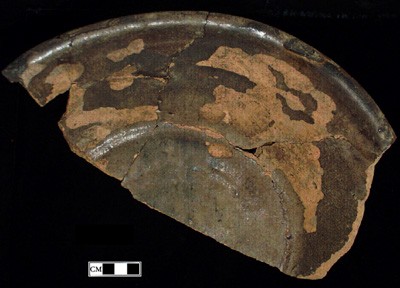 with a lead glaze interior found within the dwelling house cellar fill. 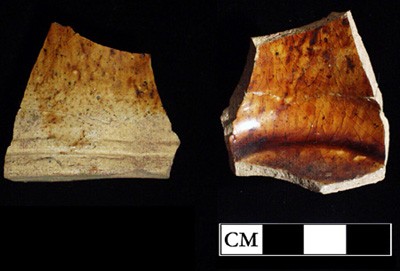 of Base of Staffordshire Mottled Ware tankard found in the top of the dwelling house cellar fill. Starting in 2000 and continuing through 2003, excavations were able to continue at the Howland site with the help of PJHS members. Each year, the week prior to the annual PJHS was spent investigating the site. With the completion of the excavation and mapping of the dwelling house in 1999 (Figure 3), our focus turned to area identified by Strickland as the "dew pond." 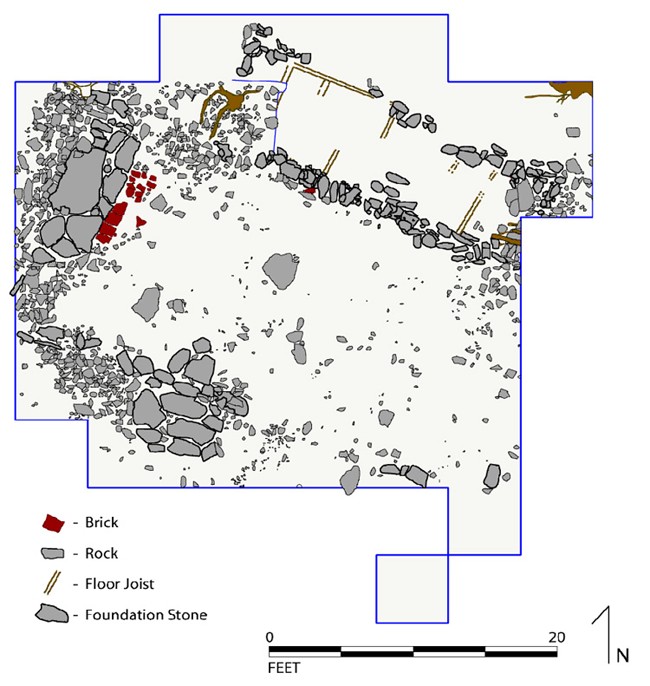 on 1998 and 1999 excavations. The first step was to figure out exactly what the feature was. In 2000, by placing test pits in the center and along the southern and western edges of the feature, we found out that we were actually excavating a cellar to another structure. Excavating the cellar fill in 2001, we uncovered a "Wood Penny" with a 1723 date (Figure 4). Excavation of the cellar fill was completed during the 2002 season. The cellar was approximately sixteen feet square and may have had a chimney on the western wall. Significantly, the alignment of the cellar did not match that of the dwelling house. The "dew pond" cellar was only a couple degrees off of magnetic north, while the dwelling house foundation was almost thirty degrees off of a north-south alignment. This indicates that the two buildings were not constructed at the same time and may suggest that the "dew pond" structure was built after the dwelling house was abandoned. 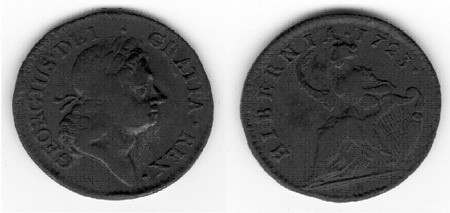 found in the "dew pond" cellar fill. The focus of this summer's work was two-fold. First, we turned our attention to the area identified as a barn by Strickland. We concentrated our attention on the two features that lead to this interpretation – the square rock pad and apparent foundation corner. Three five-foot by five-foot square test units were placed at the location of the rock pad. While many rocks were exposed and left in place during the excavation, they did not seem to form any type of pattern. A few datable English ceramics were recovered, but it was a type that was produced for almost two centuries – between 1600 and 1770. The most interesting object recovered this year was also found in these squares. It appeared to be a brass back to a button. Unfortunately, the area surrounding the foundation corner was covered in poison ivy. The ivy above ground was cleared, but its root system proved too hazardous so excavation was put off until next summer. The second focus of this summer's excavation was an initial exploration of how the inhabitants of the site organized and used the space surrounding the two structures. Four five-foot by five-foot test squares were excavated between the two structures. In two adjacent squares, we found a linear soil stain and two postholes. This could be the remains of a fence or perhaps a small outbuilding that will be confirmed by opening up a larger area. Next year, the squares on either side of the feature will be dug to determine its extent. Derek and his two associates, Jesse Sawyer and Tracy Smith, led the dig. Returning in 2003 were John and Teddy Howland, Charlotte Mader, Richard Clary and Jonathan Stubbs. First-time excavators joining the effort in 2003 were PJHS member Jan Hetterly, Charlotte's friend Jim Sutter, and Rebecca Senkowicz, niece of a PJHS member and attending MIT this summer. We hope to present further details of the findings from these excavations here in the future. © 2004 Copyright and All Rights |
| For a discussion of the Jim Deetz's excavations and interpretations of the Parting Ways site, located in Plymouth, see his 1995 Keynote Address to the Society for Historical Archaeology, and his 1996 chapter from In Small Things Forgotten. Those presentations discuss archaeological evidence found at that site, which dates from the 1790s onward, of burial practices and architectural forms consistent with elements of African-American heritage. Archaeological and historical studies of changes in grave art styles and burial practices in Plymouth and the surrounding region during the seventeenth through nineteenth centuries are summarized in Deetz and Dethlefsen's article, entitled Death's Head, Cherub, Urn & Willow, presented here with an expanded collection of illustrations. Artist Ruth Major worked with Derek Wheeler and other researchers to create the painting entitled Harvest Time at the John Howland Homestead, 1650 and a related article entitled Words Paint the Picture that describes her process of historical research in preparing that work. |
